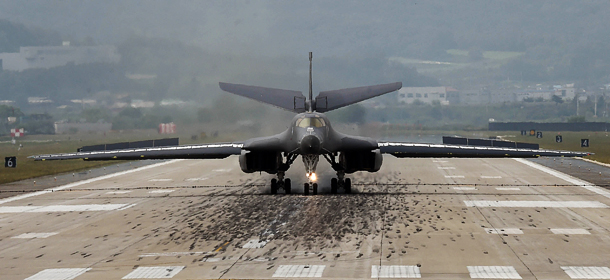U.S. shows force with B-1B flyover

A B-1B strategic bomber lands at Osan Air Force Base Wednesday after a flyover in a show of force. The U.S. Air Force sent two of its B-1B supersonic bombers from Anderson Air Force Base in Guam to South Korean airspace, one of which landed at the Osan base. It was the first time for a B-1B bomber to have landed on South Korean soil. [NEWSIS]
Two B-1B strategic bombers appeared in the air above the Osan Air Force base, 64 kilometers (40 miles) south of Seoul, at around 1:10 p.m. on Wednesday, coming from the U.S. Anderson Air Force Base in Guam. One of two supersonic bombers landed at the Osan base, which was the first time a B-1B jet has done so. It remains to be seen how long the B-1B bomber will remain at the Osan base. In the first deployment of two B-1B bombers to South Korea last Tuesday, neither touched South Korean soil.
Washington’s decision to send two B-1B bombers, known as the U.S.’s heaviest supersonic strategic bombers, which can fly at twice the speed of sound, came only eight days after the dispatch of two B-1B bombers last week in the wake of Pyongyang’s fifth nuclear test. Equipped with laser-guided high precision missiles, a B-1B is capable of hitting a moving vehicle 370 kilometers away. A B-1B could also hit a window on the third floor of the headquarters of the Workers’ Party in Pyongyang from south of the demilitarized zone. Each Boeing-made B-1B bomber costs around $317 million and the U.S. military has 62 of them.
The recent flyover comes amid growing tensions with North Korea, sparked by its latest underground nuclear test earlier this month, followed by its alleged successful test-run of a high-powered engine that experts say is designed for an inter-continental ballistic missile to target the U.S. mainland. In response to a spate of military provocations by the North, the South Korean military recently unveiled an operation plan titled “Korea Massive Punishment & Retaliation (KMPR),” in which the military vows to directly target the North Korean military and political leadership, most importantly North Korean leader Kim Jong-un, in the event of a nuclear attack by the North. The plan does not rule out the possibility of a pre-emptive strike against Pyongyang if signs of nuclear provocation are detected.
“Under the KMPR, massive fire attacks will be concentrated on the North’s wartime command centers in Pyongyang,” a defense ministry official told the JoongAng Ilbo, noting that a pre-emptive strike could be considered under such an operation scheme.
To that end, the South Korean military will fire Hyunmoo-III cruise missiles with a range of 1,000 kilometers to target core command headquarters in the North Korean capital. Seoul’s management of F-35A jets, starting from 2018, will add to its strike capability under the KMPR plan.
In military alliance with the U.S. forces, Seoul also has the Kill Chain system by which it will pre-emptively hit missile-related facilities following signs of imminent missile attacks from the North. Under the system, South Korea and the U.S. will work together to destroy mobile launch pads with F-35 fighter jets upon confirmation of missile locations provided by U.S. satellite imagery.
North Korea has nearly 1,000 ballistic missiles ready to be fired, but the number of mobile launch pads it has is estimated to be around 100. Given that only one missile can be mounted on a mobile launch pad, the allies’ can effectively undermine the North’s missile capability with a pre-emptive strike against such mobile pads.
In case the North succeeds in launching ballistic missiles from mobile launch pads left intact despite a barrage of air strikes by the South and the U.S., Patriot surface-to-air missiles will be launched to intercept incoming missiles from the North in accordance with the Korea Air and Missile Defense (KAMD) operation to protect Seoul and its surrounding areas. The Terminal High Altitude Area Defense (Thaad) system, which will be set up in Seongju County in North Gyeongsang by the end of next year, will also be activated to intercept incoming missiles.
BY KANG JIN-KYU, KIM MIN-SEOK [kang.jinkyu@joongang.co.kr]










with the Korea JoongAng Daily
To write comments, please log in to one of the accounts.
Standards Board Policy (0/250자)